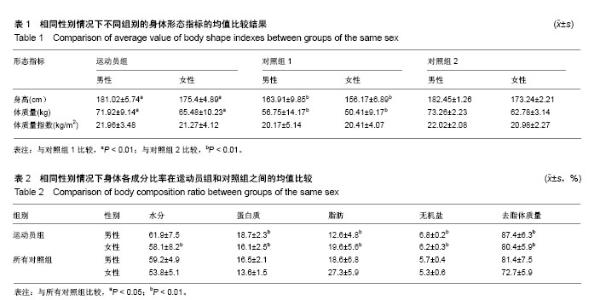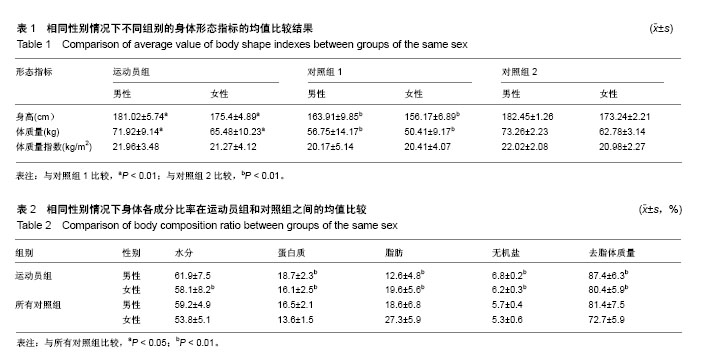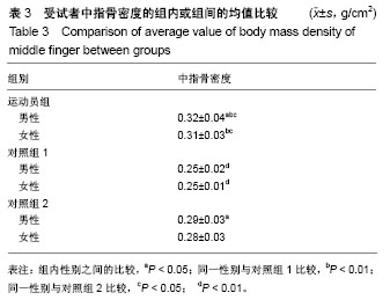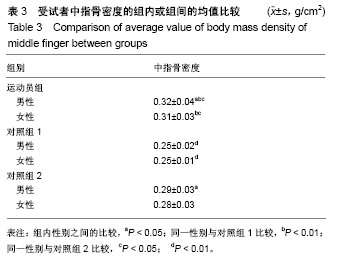Chinese Journal of Tissue Engineering Research ›› 2019, Vol. 23 ›› Issue (3): 341-347.doi: 10.3969/j.issn.2095-4344.0602
Previous Articles Next Articles
Body composition and bone mineral density of juvenile basketball players versus ordinary middle school students: data from a middle school
Zhang Yuantong
- (Department of Physical Education, Zhengzhou Chenggong University of Finance and Economics, Zhengzhou 451200, Henan Province, China)
-
Received:2018-07-13Online:2019-01-28Published:2019-01-28 -
About author:Zhang Yuantong, Lecturer, Department of Physical Education, Zhengzhou Chenggong University of Finance and Economics, Zhengzhou 451200, Henan Province, China -
Supported by:the Science and Technology Research and Development Project of Henan Province, No. 172102310163
CLC Number:
Cite this article
Zhang Yuantong. Body composition and bone mineral density of juvenile basketball players versus ordinary middle school students: data from a middle school[J]. Chinese Journal of Tissue Engineering Research, 2019, 23(3): 341-347.
share this article
Add to citation manager EndNote|Reference Manager|ProCite|BibTeX|RefWorks

2.1 受试者数量分析 试验共招募受试者560人,通过问卷调查分析后符合条件进入试验环节的共270人。 采用SPSS 20.0数据统计软件对实验所得的身体成分比率和中指骨密度相关数据进行boxplot检验,共发现中指骨密度奇异值1个,该受试者是男性篮球运动员,其骨密度值超出了正常范围。1名来自于对照组1的女性受试者身体成分指标也出现了奇异值。对于日常生活习惯指标也出现了1个奇异值,涉及到1名对照组2的男生受试者。凡是出现奇异值的受试者,其相关数据已全部进行了剔除。对于出现的极值全部进行了重复测量,发现数据具有可靠性,取2次测量数值的平均数作为最终的试验数据。因此试验受试者的有效数量为267人,其中运动员组为78人(男性27人,女性51人),对照组1为86人(男性32人,女性54人),对照组2为103人(男性39人,女性64人),其相关数据进入了统计结果。 2.2 少年篮球运动员性别不同组别身体形态指标的均值比较 见表1。 对于身高和体质量这2个指标,运动员组和对照组1比较差异有非常显著性意义(P < 0.01),运动员组和对照组2比较差异无显著性意义(P > 0.05),对照组1和对照组2比较差异有非常显著性意义(P < 0.01)。体质量指数在各组之间差异均无显著性意义(P > 0.05)。 2.3 少年篮球运动员身体各成分比率(%)和普通中学生之间的均值比较 见表2。 (1)女性少年篮球运动员身体中的总水分比率显著性的高于同性别的普通中学生(P < 0.05),而这一指标在男性的两组之间差异无显著性意义(P > 0.05); (2)对于身体中蛋白质比率,不论男女,少年篮球运动员和普通中学生之间差异都有显著性意义(P < 0.05),尤其是女性,两组之间差异有非常显著性意义(P < 0.01),具体表现为少年篮球运动员身体中蛋白质比率高于普通中学生; (3)对于脂肪和去脂体质量这两个比率指标来说,不论男女,少年篮球运动员和普通中学生之间差异都有非常显著性意义(P < 0.01),具体表现为少年篮球运动员身体中脂肪比率低,而去脂体质量比率高; (4)同性别的少年篮球运动员无机盐比率显著性高于普通中学生(P < 0.05)。"


中指骨密度在少年篮球运动员群体中存在着显著性的性别差异(P < 0.05),在身高体质量与运动员相仿的普通中学生群体中也存在显著性的性别差异 (P < 0.05),但是在不考虑身高体质量的普通中学生群体中男女之间比较差异无显著性意义(P > 0.05),这种显著性差异表现为男性中指骨密度高于女性。 相同性别的少年篮球运动员和普通中学生中指骨密度各组间的均值比较后发现:①无论男性还是女性,少年篮球运动员中指骨密度和不考虑身高体质量的普通中学生之间差异有非常显著性意义(P < 0.01),和身高体质量相仿的普通中学生之间差异也有显著性意义(P < 0.05),这些差异都表现为篮球运动员中指骨密度高于普通中学生;②无论男性还是女性,身高体质量和运动员相仿的普通中学生的中指骨密度显著性高于不考虑身高体质量的普通中学生,两者之间差异有非常显著性意义(P < 0.01)。 2.5 少年篮球运动员和普通中学生日常生活习惯各指标骨均值的性别比较和组间比较 见表4。"

| [1] 韦蕾,余一兵,俞雪春,等.专科学校篮球班男生身体成分与体质健康相关性的研究[J].广州体育学院学报,2009,29(5):108-111.[2] Smith TP,Mcnaughton LR,Marshall KJ.Effect of 4-wk training using Vmax\Tmax on VO2max and performance in athletes. Med Sci Sports Exe.1999;31(6):892-896.[3] Smith TP,Coombes JS,Geraghty DP.Optimising high-intensity treadmill training using the running speed at maximal O2 uptake and the time for which this Can Be maintained.Eur J Appsiol.2003;(89):337-343.[4] 许晓东,柏友萍,张晶,等.篮球、手球、足球运动员体成分及肌肉力量的比较分析[J].辽宁体育科技,2012,34(4):37-41.[5] 杨建雄,王健.6-21岁学生体成分的性别特点与年龄规律[J].体育科学,2005,25(8):67-70.[6] 叶心明,肖巧俐,易红赤.中国学龄儿童饮食习惯、营养摄入及与BMI相关研究[J].成都体育学院学报,2016,42(2):116-121.[7] Hung LS,Tidwell DK,Hall ME,et al.A meta-analysis of school-based obesity prevention programs demonstrates limited efficacy of decreasing childhood obesity.Nutr Res. 2015;35(3):229-240.[8] Ross R,Blair SN,Arena R,et al.Importance of assessing cardiorespiratory fitness in clinical practice:A case for fitness as a clinical vital sign:a scientific statement from the american heart association.Circulation.2016;134(24):e653.[9] Blair SN,Kohl HW,Paffenbarger RS,et al.Physical fitness and all-cause mortality.A prospective study of healthy men and women.JAMA.1989;262(17):2395-2401.[10] 李新,李晓彤,王正珍,等.不同运动量对少年心肺耐力和身体成分影响的干预研究[J].中国体育科技,2017,53(5):110-116.[11] 汪媛,金永堂.肌力和体力活动与骨密度关系研究进展[J].卫生研究,2003,32(2):169-171.[12] 沈友青,姜霞.运动与儿童少年骨密度的改变[J].武汉体育学院学报,2004,38(5):56-57. [13] 徐锋鹏,胡敏,黄俊豪,等.不同类型运动对骨密度影响的研究进展[J].上海体育学院学报,2017,41(1):55-60.[14] Frost HM.Skeletal structure adapations to mechanical usage( SATMU):1.Redefining Wolff law:the bone modeline problem.Anat Rec.1990;226(4):403-413.[15] 丁焕香.不同专项学生身体成分调查分析[J].临沂师范学院学报,2009,31(6):97-101.[16] 詹晓梅,潘珊珊,陈文鹤.运动干预对肥胖青少年体成分、血脂、胰岛素抵抗及超敏C反应蛋白的影响[J].上海体育学院学报, 2012.6(6):62-66.[17] 廖鲁頔.不同技能主导类项目运动员身体成分的比较研究-以山西技能主导类优势项目运动员为例[J]. 2015,30(5): 124-128.[18] 袁凌燕.青少年儿童肥胖干预理论与实践[M].杭州:杭州出版社, 2013,7.[19] 黄优强,周武.对中国男篮后备人才培养模式的审视[J].北京体育大学学报,2014,37(4):133-139. [20] 黄长剑,徐瑞芳.我国青少年篮球培养现状与对策—以福建省为例[J].长沙大学学报,2011,25(5):153-156. [21] 高治.我国青少年校园篮球运动发展的动力机制研究[D].武汉:武汉体育学院,2016.[22] 丁广鹏.我国7-12 岁儿童篮球启蒙训练的实证研究[J].湖北体育科技,2017,36(7):598-602.[23] 李治.明星效应对高校篮球公共课教学的影响研究[J].当代体育科技,2016,6(26):36-37. [24] 汪光胜,王东亮.中美篮球后备人才培养的比较研究[J].吉林体育学院学报,2015,31(6):36-40.[25] 吴新炎,陈月亮,李芙蓉.我国篮球儿童少年后备人才骨密度研究[J].湖北理工学院学报:人文社会科学版,2016,33(3):83-88. [26] 刘莉,姚兴家,白英龙,等.不同体成分儿童皮褶厚度性激素水平的探讨[J].中国公共卫生,2003,19(10):1186-1187.[27] 蔡富华,章晓霜,熊静宇.音、体、美、舞蹈专业教育对青春期女大学生体成分与骨密度的影响[J].广州体育学院学报, 2016, 36(1):106-108.[28] Hoy CL,Macdonald HM,Mckay HA.How does bone quality differ between healthy weight and overweight adolescents and young adults.Clin Orthop Relat Res.2012;22(2):312-326.[29] 沈华.不同形式的健身运动和体成分对中老年女性骨密度的影响[J].成都体育学院学报,2008,34(12):71-74.[30] 张永桂.巧用篮球发展中学生上肢力量[J].中国学校体育(基础教育),2017(1):83.[31] 宋新民,袁平,刘琳.不同性别年龄钙骨密度测定分析[J].微量元素与健康研究,2000,17(4):22-23.[32] 陈金标,秦林林,马海波,等.桡骨超远端体积骨密度的测量及性别间的比较[J].中日友好医院学报,2000,14(3):125-128.[33] 李天乐.太极拳练习对男性中老年体成分和睾酮及骨密度影响的研究[D].宁波:宁波大学,2015. [34] 王峰.关于降钙素降低骨质疏松性骨折发病率的临床分析[J].中国实用医药,2015,10(2):163-164.[35] 杨路昕,郭郡浩,蔡辉.运动干预原发性骨质疏松症:不同运动方式、强度及频率对骨密度的影响[J].中国组织工程研究, 2014, 18(38):6200-6204.[36] 刘云发,陶萍,石丽杰.不同生活方式对60-69岁老年人骨密度的影响[J].沈阳体育学院学报,2013,32(5):99.[37] Cizza G.Major depressive disorder is a risk factor for low bone mass,central obesity,and other medical condition.Dialogues Clin Neurosci.2011;13(1):73-87.[38] Watts NB,GLOW investigators. Insights from the Global Longitudinal Study of Osteoporosis in Women( GLOW).Nat Rev Endocrinol.2014;10(7):412-22.[39] Turner AG,Anderson PH,Morris HA.Vitamin D and bone health.J Clin Lab Invest Suppl.2012;243(4):65-72.[40] 王亮,马远征,张妍,等.北京地区9103例体检人群骨密度流行病学调查研究[J].中国骨质疏松杂志,2014,20(8):952-955.[41] 易波,文重远,孙永林,等.脂肪分布对不同年龄正常人群骨密度的影响[J].中国骨质疏松杂志,2012,18(7):610-613,617. [42] 程淑敏,于大芳,郭文娟.3-10岁儿童年龄、身高及体重指数对全身及各部位骨密度的影响[J].现代预防医学, 2007,34(24): 4690-4691.[43] 邢晨芳,黄皓月,周颖,等.深圳市成年男性超声骨密度检测结果分析[J].现代医用影像学,2015,24(6):944-945,957. [44] 张莹,吴景欢,洪平,等.北京地区18-30岁成人骨密度影响因素分析[J].营养学报,2016,38(3):229-233.[45] 王纯,杨泽宏.成都市中老年健身女性体成分指标与骨密度和骨代谢指标的相关性研究[J].中国骨质疏松杂志, 2007,13(11): 779-782.[46] 周莉,秦建平,邹丽华,等.253例青少年腰椎骨密度分析[J].中国骨质疏松杂志,2014,20(4):662-665.[47] 莫娟,欧阳俊.年龄和体重指数对中青年男性骨密度的影响[J]. 中国骨质疏松杂志,2015,21(3):310-313.[48] 阿斯木古丽•克力木,热依拉•阿不拉,阿孜亚•赛辽汗.1092例0-6 岁儿童骨密度与体格发育调查[J].中国妇幼保健, 2014, 29(6):917-919. [49] 李雪莹.健美操锻炼对肥胖女大学生身体成分及身体形态影响的研究[J].辽宁体育科技,2017,39(2):54-56.[50] 王磊,王新雷.中北大学男跆拳道运动员身体成分与无氧代谢的研究[J].湖北体育科技,2016,35(10):869-872.[51] 蔡壮,王世超.不同田径专项专修男性大学生身体成分与体质特征比较-以山西省五所体育院校为例[J].南京体育学院学报(自然科学版),2016,15(3):73-75.[52] 肖丽娜.上海市青少年游泳运动员身体成分特征的研究[D].北京:北京体育大学,2016.[53] 崔建梅,郭旭玥,李中华,等.太极拳锻炼对大学体育保健班学生心功能指数及身体成分的影响[J].中国学校卫生, 2016,37(3): 432-434.[54] 李荣娟,张瑞,陆碧琼,等.气排球运动对中老年女性身体成分及骨密度和肌肉力量的影响[J].内蒙古师范大学学报(自然科学汉文版),2016,45(2):285-288.[55] 石峰.长期空竹锻炼老年人身体成分与体质特征[J].中国老年学杂志,2015,35(14):3955-3956. [56] 徐金庆.体育院系篮球专修大学生运动员体成分特征分析[J].宜春学院学报,2017,39(3):93-96.[57] 陈孝道.武术专选与篮球专选学生体成分的对比分析[J].体育研究与教育,2011,(s1):207-209.[58] 刘龙祥.抗阻训练对青少年骨密度的影响研究[J].当代体育科技, 2017,7(23):213-214.[59] 费加明.不同运动方式对绝经后妇女身体形态、肺活量及骨密度的影响[J].中国应用生理学杂志,2017,33(4):339-341.[60] 钱芊.大学生田径运动员和普通大学生不同部位骨密度的均值比较[J].中国组织工程研究,2017,21(32) :5097-5102. |
| [1] | Zhang Tongtong, Wang Zhonghua, Wen Jie, Song Yuxin, Liu Lin. Application of three-dimensional printing model in surgical resection and reconstruction of cervical tumor [J]. Chinese Journal of Tissue Engineering Research, 2021, 25(9): 1335-1339. |
| [2] | Zeng Yanhua, Hao Yanlei. In vitro culture and purification of Schwann cells: a systematic review [J]. Chinese Journal of Tissue Engineering Research, 2021, 25(7): 1135-1141. |
| [3] | Yang Weiqiang, Ding Tong, Yang Weike, Jiang Zhengang. Combined variable stress plate internal fixation affects changes of bone histiocyte function and bone mineral density at the fractured end of goat femur [J]. Chinese Journal of Tissue Engineering Research, 2021, 25(6): 890-894. |
| [4] | Xu Dongzi, Zhang Ting, Ouyang Zhaolian. The global competitive situation of cardiac tissue engineering based on patent analysis [J]. Chinese Journal of Tissue Engineering Research, 2021, 25(5): 807-812. |
| [5] | Wu Zijian, Hu Zhaoduan, Xie Youqiong, Wang Feng, Li Jia, Li Bocun, Cai Guowei, Peng Rui. Three-dimensional printing technology and bone tissue engineering research: literature metrology and visual analysis of research hotspots [J]. Chinese Journal of Tissue Engineering Research, 2021, 25(4): 564-569. |
| [6] | Chang Wenliao, Zhao Jie, Sun Xiaoliang, Wang Kun, Wu Guofeng, Zhou Jian, Li Shuxiang, Sun Han. Material selection, theoretical design and biomimetic function of artificial periosteum [J]. Chinese Journal of Tissue Engineering Research, 2021, 25(4): 600-606. |
| [7] | Liu Fei, Cui Yutao, Liu He. Advantages and problems of local antibiotic delivery system in the treatment of osteomyelitis [J]. Chinese Journal of Tissue Engineering Research, 2021, 25(4): 614-620. |
| [8] | Li Xiaozhuang, Duan Hao, Wang Weizhou, Tang Zhihong, Wang Yanghao, He Fei. Application of bone tissue engineering materials in the treatment of bone defect diseases in vivo [J]. Chinese Journal of Tissue Engineering Research, 2021, 25(4): 626-631. |
| [9] | Zhang Zhenkun, Li Zhe, Li Ya, Wang Yingying, Wang Yaping, Zhou Xinkui, Ma Shanshan, Guan Fangxia. Application of alginate based hydrogels/dressings in wound healing: sustained, dynamic and sequential release [J]. Chinese Journal of Tissue Engineering Research, 2021, 25(4): 638-643. |
| [10] | Chen Jiana, Qiu Yanling, Nie Minhai, Liu Xuqian. Tissue engineering scaffolds in repairing oral and maxillofacial soft tissue defects [J]. Chinese Journal of Tissue Engineering Research, 2021, 25(4): 644-650. |
| [11] | Xing Hao, Zhang Yonghong, Wang Dong. Advantages and disadvantages of repairing large-segment bone defect [J]. Chinese Journal of Tissue Engineering Research, 2021, 25(3): 426-430. |
| [12] | Chen Siqi, Xian Debin, Xu Rongsheng, Qin Zhongjie, Zhang Lei, Xia Delin. Effects of bone marrow mesenchymal stem cells and human umbilical vein endothelial cells combined with hydroxyapatite-tricalcium phosphate scaffolds on early angiogenesis in skull defect repair in rats [J]. Chinese Journal of Tissue Engineering Research, 2021, 25(22): 3458-3465. |
| [13] | Wang Hao, Chen Mingxue, Li Junkang, Luo Xujiang, Peng Liqing, Li Huo, Huang Bo, Tian Guangzhao, Liu Shuyun, Sui Xiang, Huang Jingxiang, Guo Quanyi, Lu Xiaobo. Decellularized porcine skin matrix for tissue-engineered meniscus scaffold [J]. Chinese Journal of Tissue Engineering Research, 2021, 25(22): 3473-3478. |
| [14] | Mo Jianling, He Shaoru, Feng Bowen, Jian Minqiao, Zhang Xiaohui, Liu Caisheng, Liang Yijing, Liu Yumei, Chen Liang, Zhou Haiyu, Liu Yanhui. Forming prevascularized cell sheets and the expression of angiogenesis-related factors [J]. Chinese Journal of Tissue Engineering Research, 2021, 25(22): 3479-3486. |
| [15] | Liu Chang, Li Datong, Liu Yuan, Kong Lingbo, Guo Rui, Yang Lixue, Hao Dingjun, He Baorong. Poor efficacy after vertebral augmentation surgery of acute symptomatic thoracolumbar osteoporotic compression fracture: relationship with bone cement, bone mineral density, and adjacent fractures [J]. Chinese Journal of Tissue Engineering Research, 2021, 25(22): 3510-3516. |
| Viewed | ||||||
|
Full text |
|
|||||
|
Abstract |
|
|||||

